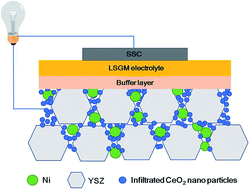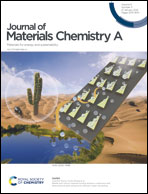Infiltration of cerium into a NiO–YSZ tubular substrate for solid oxide reversible cells using a LSGM electrolyte film
Abstract
A NiO–Y2O3 stabilized ZrO2 (NiO–YSZ) supported tubular solid oxide cell, which consists of a La0.9Sr0.1Ga0.8Mg0.2O3−δ (LSGM) dip-coated electrolyte film and Sm0.5Sr0.5CoO3−δ (SSC) air electrode, was prepared and its power generation and electrolysis performance in the intermediate temperature range were investigated. Compared to other rare earth oxides studied, infiltration of Ce nitrate into the substrate was the most effective for increasing cell performance in the case of 2 M infiltration. Moreover, it was found that the infiltration of a higher concentration of the Ce solution increased the maximum power density, because both IR loss and overpotential were significantly decreased. The maximum power density of the cell was 0.95 and 0.42 W cm−2 at 873 and 773 K, respectively at 3 M Ce nitrate infiltration. The long-term stability of the cell was also measured by using the cell infiltrated with 1.5 M Ce, and a stable power generation performance was demonstrated up to 100 h. The steam electrolysis performance of the cell using Ce infiltration was further studied and it was found that Ce also contributes to higher current density in SOEC operation and 1.07 A cm−2 at 1.6 V was achieved at 873 K using 2 M Ce infiltration.



 Please wait while we load your content...
Please wait while we load your content...